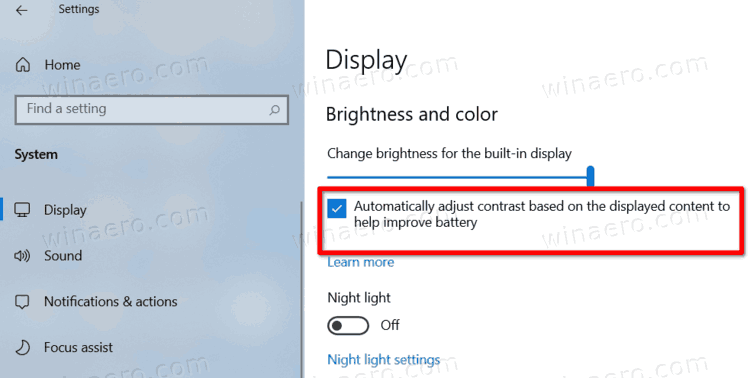In the latest Windows 10 build 21354, Microsoft introduced a new feature that allows users to disable content adaptive brightness control (CABC) when supported by hardware. Here's what is the CABC feature and how to disable it.
Advertisеment
What is Content Adaptive Brightness Control (CABC)
Content Adaptive Brightness Control is a special technology that dynamically changes your screen's brightness and contrast to preserve the battery. It complements more traditional screen brightness controls, such as a manual slider or adaptive brightness that depends on lightning conditions (auto-brightness.) What differs Content Adaptive Brightness Control from the latter is that CABC changes the screen brightness depending on the content you are currently watching. For example, a computer may lower the screen brightness when you work with a bright app, such as a text editor.
If your computer screen randomly lowers or increases brightness, changes the contrast, and experiences what seems to be graphical anomalies, that may be the result of CABC.
CABC is not new to Windows. Some computers allow managing this feature via a GPU driver; others have CABC built into the firmware. Also, some monitors have dedicated Content Adaptive Brightness mechanisms separated from the video source and accessible from on-display menus.
Many users find it distracting and annoying when their PCs change the screen parameters based on the displayed content. CABC can be particularly irritating for professionals and content creators. With Windows 10 build 21354, you can finally disable Content Adaptive Brightness Control from Windows Settings.
How to Disable Content Adaptive Brightness Control in Windows 10
- Open Settings, e.g. using the Win + I shortcut keys.
- Navigate to System > Display.
- Find the Brightness and color section.
- Turn off (Uncheck) the Automatically adjust contrast based on the displayed content entry below the brightness slider.

Be aware that the settings above are currently available in preview versions of Windows 10 from the Dev Channel. Microsoft expects to ship them option to the production branch of the OS in the second half of 2021, along with many significant changes to the operating system.
Finally, if you do not see the mentioned above options in the Settings app, it may be because your hardware does not support the CABC function.
Support us
Winaero greatly relies on your support. You can help the site keep bringing you interesting and useful content and software by using these options:

This is is fab to know! CABC has been the most annoying feature!
is there an estimated release date for this update? or, at least when access to this feature is made mainstream?
Cheers!
21H2
My PC (Dell Vostro 3500) does keep changing brightness when I switch between apps and windows in battery mode (not when plugged in), but I don’t have these options in Settings. Does this mean that there is no way for me to turn this off??